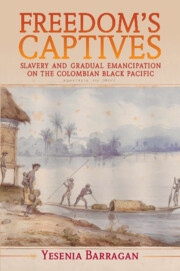Book contents
- Freedom’s Captives
- Afro-Latin America
- Freedom’s Captives
- Copyright page
- Dedication
- Epigraph
- Contents
- Figures
- Tables
- Acknowledgments
- Introduction
- Part I The Social Universe of the Colombian Black Pacific
- Part II The Time of Gradual Emancipation Rule
- 3 The Gradual Emancipation Law of 1821 and Abolitionist Publics in Colombia
- 4 The Children of the Free Womb and Technologies of Gradual Emancipation Rule
- 5 Routes to Freedom, Gradients of Unfreedom
- Part III Final Abolition and the Afterlife of Gradual Emancipation
- Epilogue
- Bibliography
- Index
3 - The Gradual Emancipation Law of 1821 and Abolitionist Publics in Colombia
from Part II - The Time of Gradual Emancipation Rule
Published online by Cambridge University Press: 18 June 2021
- Freedom’s Captives
- Afro-Latin America
- Freedom’s Captives
- Copyright page
- Dedication
- Epigraph
- Contents
- Figures
- Tables
- Acknowledgments
- Introduction
- Part I The Social Universe of the Colombian Black Pacific
- Part II The Time of Gradual Emancipation Rule
- 3 The Gradual Emancipation Law of 1821 and Abolitionist Publics in Colombia
- 4 The Children of the Free Womb and Technologies of Gradual Emancipation Rule
- 5 Routes to Freedom, Gradients of Unfreedom
- Part III Final Abolition and the Afterlife of Gradual Emancipation
- Epilogue
- Bibliography
- Index
Summary
Chapter 3 departs from the Colombian Pacific and ventures to the eastern Andean highland town of Cúcuta, where white slaveholding delegates from across Gran Colombia (and one from Mexico) established the policy of gradual emancipation. After surveying historical precedents for and factors leading up to the 1821 gradual emancipation law’s adoption, including Antioquia’s gradual abolition law of 1814 and the Haitian Revolution, the chapter turns to the contentious debate over the Free Womb law and the question of slaveholders’ compensation. Delegates principally wrestled over the age at which Free Womb children’s bondage would be terminated and over the parameters of their salability, grounding arguments in Enlightenment thought and colonial racial accounting ideas of the development life cycles of enslaved people. Here I also examine the debates and conditions for the trafficking of Free Womb children, a phenomenon I refer to as the Free Womb trade that adopted specific legal parameters regarding puberty and geography. The chapter ends by exploring the combative and regionalized public spheres of abolition and antiabolition that developed across Gran Colombia in the 1820s.
Keywords
- Type
- Chapter
- Information
- Freedom's CaptivesSlavery and Gradual Emancipation on the Colombian Black Pacific, pp. 107 - 158Publisher: Cambridge University PressPrint publication year: 2021



